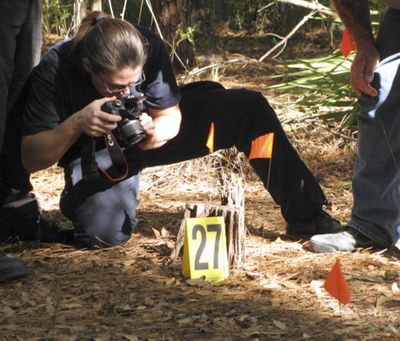Vets can learn forensic tricks
Animal CSI training offered at University of Florida

GAINESVILLE, Fla. – When federal investigators working the Michael Vick dogfighting case needed someone to dig up and analyze the remains of eight pit bulls buried on the football star’s Virginia property, they summoned Melinda Merck.
The nation’s top forensic veterinarian, Merck was one of the few specialists trained in processing crime scenes involving animals. Her job at the American Society for the Prevention of Cruelty to Animals involves helping prosecutors build court cases, and she saw there weren’t nearly enough vets and other professionals with those skills.
The 46-year-old Merck is trying to change that, co-founding a first-of-its-kind veterinary forensic science training program at the University of Florida. She and scientists from the university’s renowned human forensics lab are sharing their expertise with animal-cruelty investigators, police and veterinarians who come from around the world.
In a nod to the popular TV shows, it’s already being called “Animal CSI.”
Demand for forensic veterinarians has been growing as many states have toughened their animal cruelty laws. And law enforcement agencies nationwide have increasingly recognized that those who abuse animals are likely to eventually commit crimes against people.
Hands-on seminars teach participants crime-scene processing and the preservation of evidence in cases of animal abuse and neglect such as those involving puppy mills, dogfighting and animal hoarding. Elements include exhuming remains, analyzing hair, fibers and blood splatter, and even how insect life cycles and plant growth can yield clues about an animal’s death.
“With animal cruelty, there are usually no witnesses – or reluctant witnesses – and certainly the victims can’t testify, even if they’re alive,” Merck said. “So they’re always evidence-based cases.”
A partnership between the ASPCA and the university’s William R. Maples Center for Forensic Medicine, the program has already trained around 200 people, mostly through two- and three-day sessions. A certification program in the subject for the university students is in the works.
On a warm afternoon deep in a forest near Gainesville, teams of six are sifting through cordoned-off “crime scenes,” seeking evidence of buried animal remains. Each group has a scenario – for instance, one is investigating ritualistic animal sacrifice; others are looking into cases of animals being shot, strangled and stabbed by abusers. The students processed the carefully staged scenes, learning to build a criminal case that will stand up in court.
“We all get abuse or suspected abuse cases,” says Cheryl Clark of San Diego, a veterinarian for more than three decades who took meticulous notes as her group unearthed shreds of potential evidence at their site. “At this point in my career, I want to get some more precise knowledge to help other professional veterinarians. I want to help animals on a more global scale, so I think the way to do it is prosecute abusers and try to get laws changed and improved.”
Last year, Merck marshaled university-trained forensic teams to 25 different crime scenes and helped break up the largest suspected dogfighting ring in U.S. history. The investigation rescued more than 400 pit bulls from six states and led to 26 arrests.